Varieties of indoor roses and caring for them at home
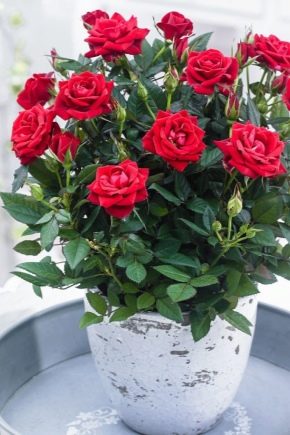
Flowering crops that can be grown in urban apartments and houses have always been very popular. Indoor roses are varieties of similar ornamental flowering plants that are in demand among amateur gardeners. This is due to the attractiveness of the flowering rose, which, with proper care, can not only be grown, but also propagated at home.

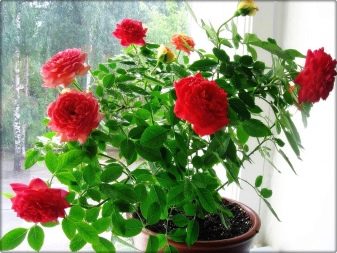

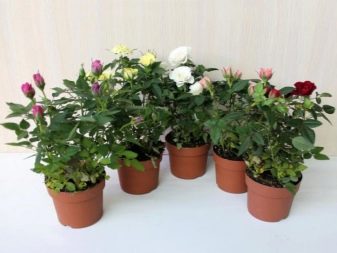
Peculiarities
Despite the fact that we are much more accustomed to seeing roses in greeting bouquets or in a flower bed, there are many varieties of this plant that are quite possible to grow on window sills or loggias in apartments and houses. As a rule, for the most part it is a miniature flowering bush, the height of which rarely exceeds half a meter. Indoor roses, as well as crops growing in flower beds, can have a wonderful scent, not inferior to the scent of lavender or jasmine. However, there are varieties of indoor roses that do not smell at all.
As for the color variety, in this case, mini-roses are not inferior to plants that are cultivated in front gardens. As practice shows, in order to acquire such a flowering bush at home, it is not necessary to acquire a decorative domesticated version. Since it is quite possible to grow a garden culture at home, but subject to certain requirements for indoor conditions. This applies to the large area of the room, as well as ensuring a cold dormant period in the winter months, which is not always possible to implement in urban apartments.
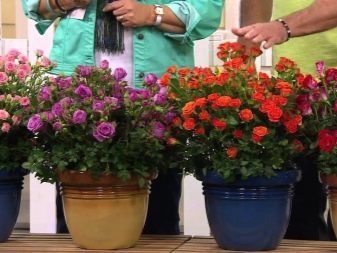
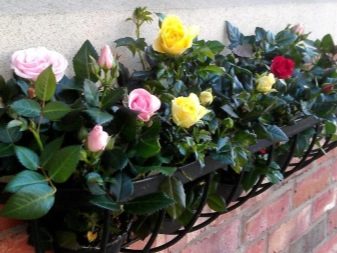


That is why, for indoor cultivation, amateur flower growers are offered miniature flowering bushes, which, with appropriate care, will delight the eye with abundant and long flowering at home. Experience shows that if you provide the plant with proper care, then it will bloom every 2-3 months throughout the year.
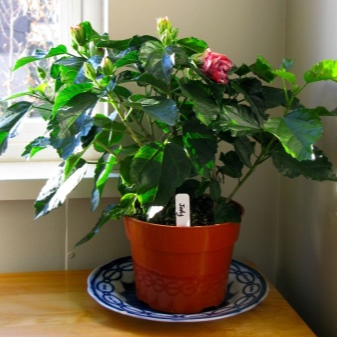
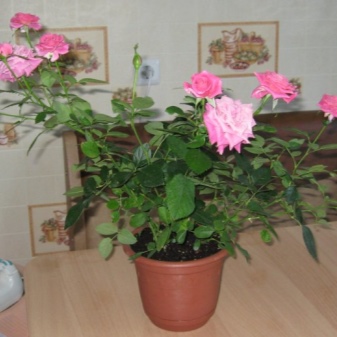
Types and varieties
Today on sale you can find a large number of different varieties of indoor roses. But the following plant varieties are most in demand.
Baby masguerade
This species is a small bush, the height of which in adulthood does not exceed 30-40 centimeters. But despite its minimal size, the culture develops powerful and bushy shoots. There are practically no thorns on the rose, and the foliage of a healthy plant will be painted in a rich dark green color. With the green mass of the variety, chameleon flowers, which bloom in inflorescences, expressively contrast, their number can be from 5 to 12 pieces.
A distinctive feature of this type of indoor rose is the ability of flowers to change their color several times. First, the plant develops lemon buds, which eventually acquire a pink hue, and in the final phase of flowering, Baby Masguerade will have scarlet roses. Among the individual characteristics of the plant, it is also worth highlighting immunity to most fungal ailments and a very delicate aroma from flowers.
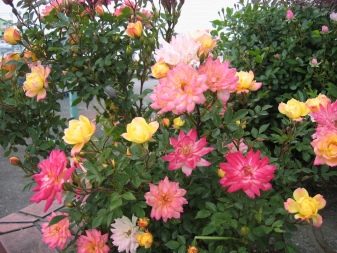
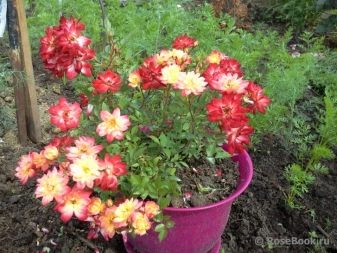
Angela rippon
This variety should be classified as a miniature indoor plant, however, during flowering, the culture stands out with a large number of flowers with a rich aroma. As a rule, up to 5 buds are formed in inflorescences. The height of the bush itself does not exceed 40 centimeters.The variety stands out for the absence of the need for pruning, in addition, the culture is very susceptible to various diseases, therefore it needs regular preventive measures.
A small-flowered rose should be grown in small pots, with frequent fertilization of the soil and the introduction of foliar dressings.
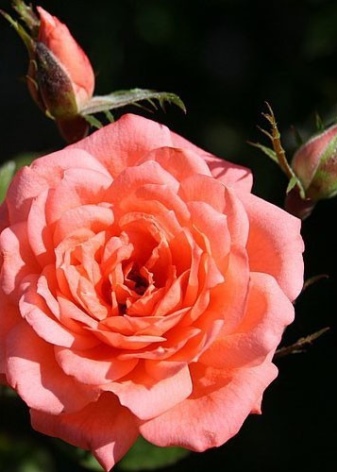
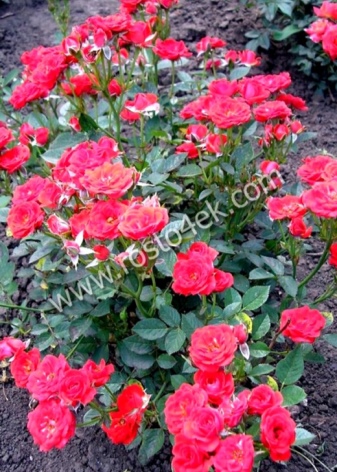
Aester morning
On the rose during the flowering period, double flowers of a creamy white color are formed, the width of which varies within 3-4 centimeters. The bushes of this variety are small, but rather dense, with dark green foliage. As a rule, the total number of inflorescences on a plant does not exceed 30 pieces, the rose has an unobtrusive aroma, and blooms almost constantly.
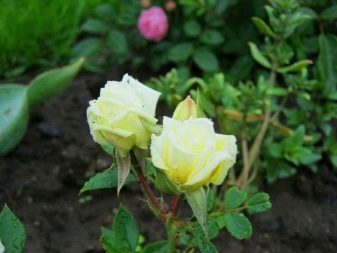
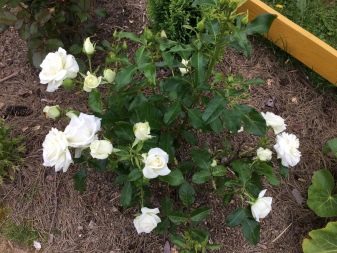
Fire princess
The bushes of this variety are of medium height, the shoots develop straight. The foliage of the rose has a dark green color with jagged edges. The culture blooms with orange-red roses, which are formed in inflorescences at the very top of the shoots. The variety is susceptible to fungal ailments, therefore needs regular prevention.
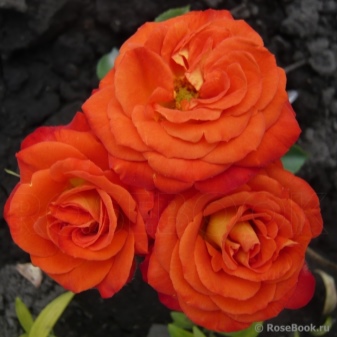
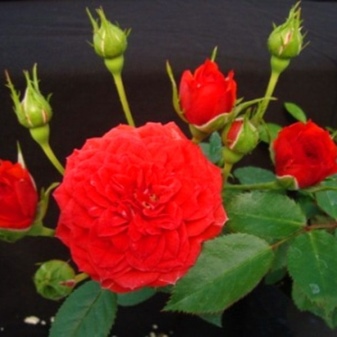
Colibri
This variety is represented by compact and dense bushes about 30 centimeters high. The shoots are distinguished by their slight slope, the foliage on the rose is dense, green, with a characteristic shine. Flowers are from 4 to 5 centimeters wide, include 20-25 petals. This variety is remarkable for its tea fragrance in the flowering phase. The color of the buds varies from apricot to yellow. Roses are formed in inflorescences, the number of which, according to the description, ranges from 2 to 5 pieces.
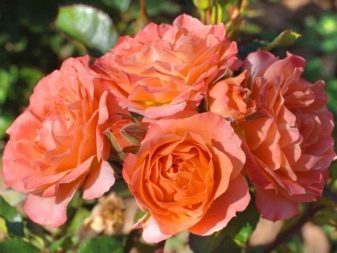
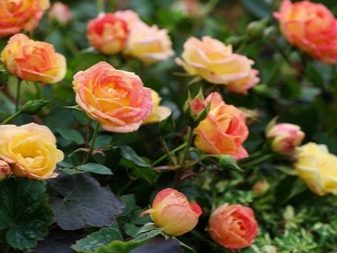
Yellow doll
The plant, which was bred about half a century ago, is an ornamental flowering bush, the height of which will be about 30 centimeters. The culture stands out for its abundant and lush bloom. The rose buds are colored lemon. The splendor of the flowers is due to the presence of a large number of petals, reaching 50 pieces.
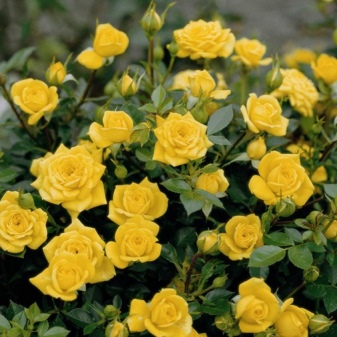
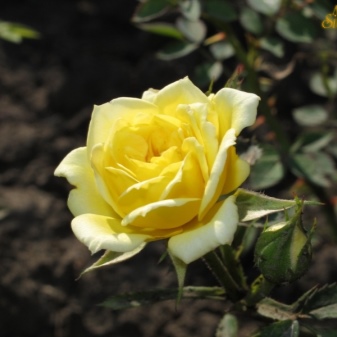
Green ice
Among all varieties of indoor roses, this type is in demand due to its size. An adult plant can grow up to 60-65 centimeters with branches up to 80 centimeters wide. The culture has good resistance to most fungal ailments that indoor flowers suffer from.
The cultivar is also popular due to its flowering characteristics, which occurs almost continuously. Green Ice's buds are pink, but the flowers bloom in a delicate white with greenery. As a rule, there is a green spot in the middle of the flower. On inflorescences there are from 2 to 5 flowers.
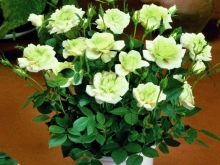
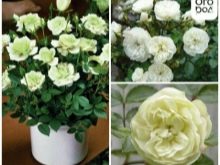
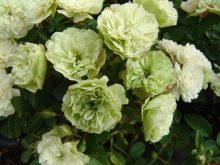
Landing
After purchasing an indoor flower, the new owner must perform a number of mandatory works, which will help the plant quickly adapt to home conditions.
- First, the culture must be washed. It is best to do this in the bathroom with the help of a shower, but you should pay close attention to the temperature of the water - it should be warm. This procedure will help not only remove dust accumulated on the leaves, but also act as a preventive measure against such dangerous pests as mealy mites.
- The next step for the gardener will be a transplant. For a flowering plant, it is worth choosing a container larger in volume than the one in which it grew and developed before. A special soil mixture should be poured into the pot, and a rose should be placed in the middle. During the work, care must be taken not to damage the root system of the crop. It is not necessary to untangle the roots together with the old soil, it would be more correct to place the flower together with the earthen clod, and sprinkle it on top with new earth. Also, before rooting, it is worth considering how many independent bushes are in the pot, since very often, for abundant flowering, store roses are rooted in one container at a time, several pieces.
Flowers growing together will interfere with each other's development in the same container, so it will be more correct to plant them. Thus, you can get several plants you like at once for growing at home.
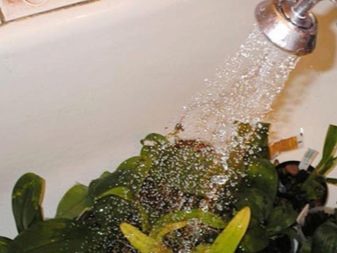
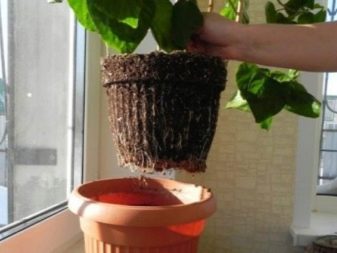
- After transplanting, the flower must be processed without fail with a composition called "Aktara", which will help to destroy pests, if any, were brought along with the rose from the store. For prophylaxis, the substance should be dissolved in a proportion of 1 gram to 10 liters of water for processing green mass. In some cases, for prevention, you can use "Fitoverm" or "Fitosporin".
- If there are dried or blackened leaves on the bush, it is best to remove them., leaving only healthy leaves on the transplanted plant. It is also recommended to cut off faded flowers.
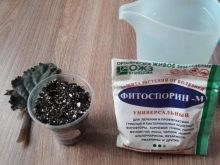


After carrying out all the obligatory transplantation measures, you can select the most suitable place for the rose in the house.
How to take care of it properly?
After the purchase and transplantation for the plant, a rather difficult adaptation period begins, during which maximum attention must be paid to the room rose. Otherwise, there is a high probability that the bush will die very soon.
If, for one reason or another, the rose grows for the first time in the pot in which it was purchased, then in this case the initial care will consist in carrying out the following work.
- Flowers are most often sold in cellophane packaging. After the rose is at home, you need to remove the wrapper from it. Despite the fact that it provides a certain moisture and microclimate for the plant inside, thanks to the additional material, fungal diseases can begin to develop in the culture in the light of the multiplication of pathogenic microorganisms in a humid environment. Another disadvantage of packaging is considered to be the obstruction of natural air exchange, which will slow down the transition of the plant to the flowering phase.
- It is also important to correctly arrange the bush after purchase. For this, dried shoots are removed, in addition, if a blooming rose was bought, all the buds must also be removed with a pruner. Such manipulation is necessary in order for the plant to devote all its strength to adaptation. And flowering, which was stimulated by artificial drugs, will take away all resources. It is also worth cutting off the bearing shoots.
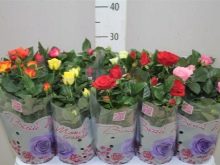


For the most part, caring for indoor varieties of roses is not much different from similar work related to horticultural crops. The only significant difference is the fact that street crops are found in natural conditions, where the phases of flowering, growth and dormancy depend on nature. And indoor flowers will be completely dependent on the person and the conditions that he will create for the plant inside the dwelling.
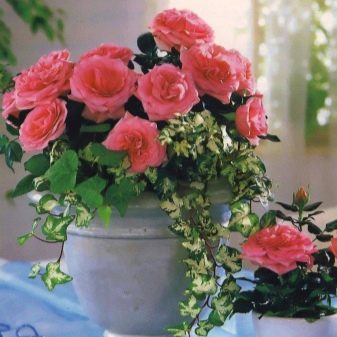

There are a number of basic points to consider when caring for a room rose.
Lighting
In order for the flower to develop correctly, it needs the maximum amount of light, but in this matter it is worth avoiding direct sunlight on the crops, which can provoke burns on the green mass. The preferred side for placing pots with roses will be the south, you can also stay in the southeast with the maximum light level in the morning, or choose the southwest, in which case the sun will hit the flower in the evening.
Also, the presence of fresh air has a positive effect on the development of indoor roses, so the room with the culture should be regularly ventilated. Alternatively, flowers can be grown on a warm loggia.

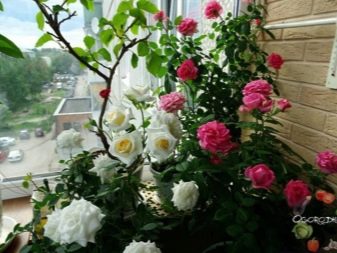
The culture values space very much, so it should be grown in a separate place, avoiding co-cultivation with many other plants. Also, the rose pot should be regularly turned in different directions towards the light, so the stems and shoots will grow evenly on each side.
The flower will react extremely negatively to electromagnetic radiation, therefore it is better to place the rose away from household electrical appliances, monitors and computers.

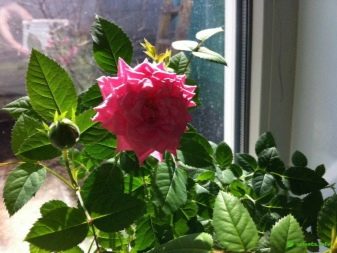
Air temperature
In the summer, when the flower blooms profusely, you can leave the rose on the balcony or take it out to the veranda, place the pot in the front garden. However, the culture is unlikely to endure the intense heat. You should also avoid direct sunlight on the plant in summer.
Care should be taken to overheat the soil if the plant is outside the dwelling in the summer. To do this, cover the pots with light or reflective material. If there is no possibility or desire to send a rose for the summer to fresh air, then the room temperature for the flower will be quite suitable, but the rose should be protected from air conditioners and other appliances with cold air currents.
Dry air should be avoided in the room, especially during the heating season.
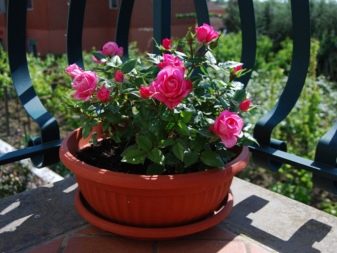
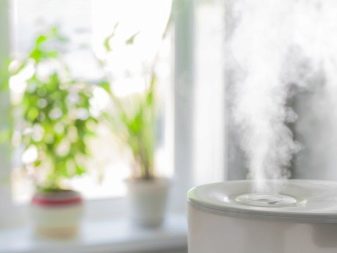
Rest phase
A feature of the winter period for an indoor flower is the phase when the plant slows down its development processes and does not bloom. At this time, it is necessary to provide the rose with suitable conditions in the room. First of all, this concerns air heating, the rose does not withstand the high temperature during this period, which will remain in the rooms in the light of the heating season. Therefore, the gardener must take care of creating a place for the flower where the air will not warm up by more than +8 degrees. If the rose is in winter in optimal conditions for it, then in the spring it will provide it with good and long flowering. Signs of the beginning of wintering are yellow leaves on the bushes.
If in the resting phase the rose will be on the veranda or on the balcony, the flower pot should be slightly insulated so as not to provoke hypothermia of the underground part of the bush. As a rule, by the beginning to mid-February, the rose will begin to leave the resting phase.
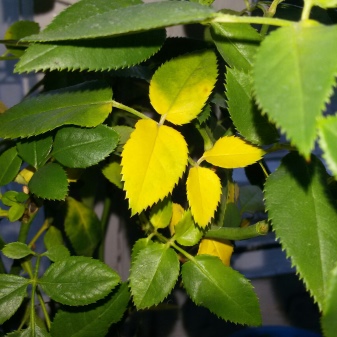
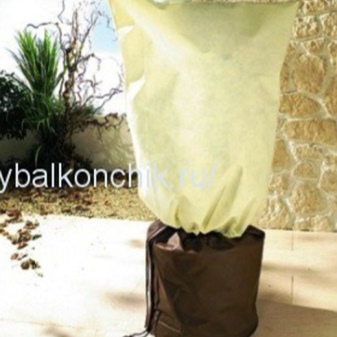
Moisturizing and watering
In the summer, the rose will need frequent and abundant watering, however, flowers that spend summer outdoors should be protected from waterlogging of the soil, which can be triggered by precipitation. In winter, the plant is rarely watered. The flower should be transferred to minimum watering gradually, immediately after the end of the flowering phase. In the process of budding, moisture should be moderate, and as the green mass grows, the plant may require more moisture.
Watering and spraying should be carried out with settled water at room temperature. Spraying is extremely important in the active growth and flowering phase. During this period, it is also allowed to wash the flowering bush under the shower, but not more often than once a week.
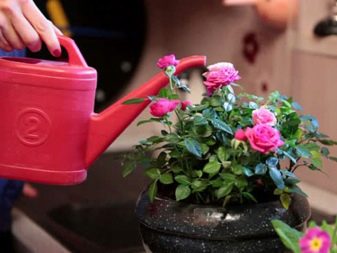
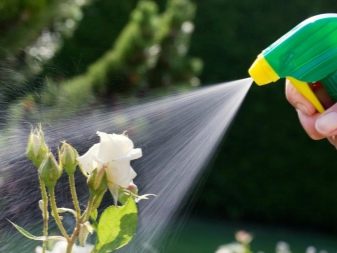
Fertilizer
In additional feeding, the rose will need a bud-setting and flowering phase. As a rule, flower growers carry out supplementary feeding weekly using formulations for indoor flowering plants. Closer to autumn, it is worth stopping the use of fertilizers.
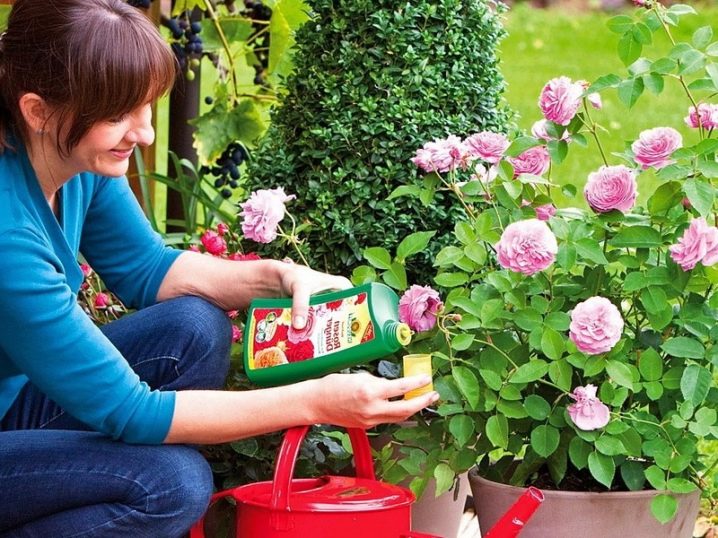
Reproduction
You can get a new culture using cuttings. The collection of breeding material should be carried out in the fall, after the planned pruning of the bush has been completed. From the cut material, you need to pick up the strongest cuttings, which have about 3-4 buds.
The optimal length of seedlings will be 14-15 centimeters. Selected shoots must be placed in water. After 2-3 weeks, roots should appear on them. To obtain good roots, shoots can be left in water until spring arrives, when they can be transplanted into the ground.
The transplanted material must be covered with polyethylene, a cut-off bottle, or a young rose must be grown for the first time in plastic cups. The shelter should be removed from the cuttings gradually, but only after the first leaf plates begin to form on the plant.
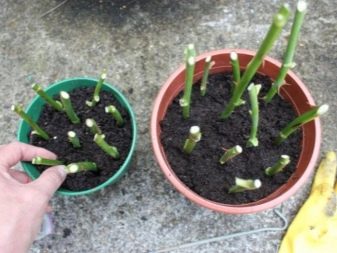
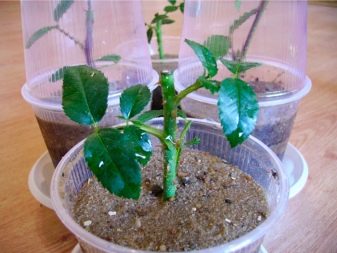
Pruning
Typically, indoor cropping is done after flowering. As an additional work on the formation of a bush, you can prune in the spring, and during this period you need to cut off dried shoots, if any.
In order for the rose to grow and develop correctly, after cutting the branches, at least 5 buds should remain on each shoot. All the rest must be separated from the bush. To properly cut an elongated bush, you need to follow the same rules, otherwise, the flower will not bloom, since the plant will direct all its forces into the growth of shoots.
It is also necessary to cut off faded roses, which can still be fed by the juices of the culture, in addition, they will spoil the appearance of the plant.
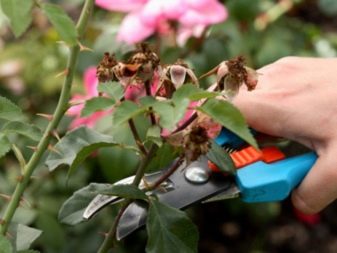
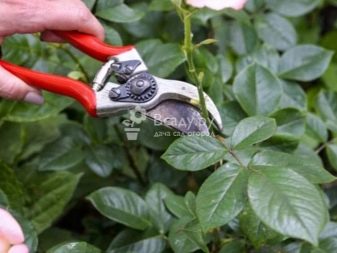
Transfer
In addition to the initial transplant of the indoor rose bush after purchase, the plant requires an annual planned transplant, which should be carried out every spring. It is important to have time to transplant the crop into new soil and a larger pot before flowering.
You can determine the need for a full or partial transplant after the rose leaves the resting phase. If no significant changes are observed, then the sensitive root system of the culture should not be disturbed once again. It will be enough to remove the top layer of the earth, move the bush to a new pot, add fresh substrate.
If the root system looks unhealthy, then the plant will need pruning of decayed or dried out parts with a complete transplant into new soil.
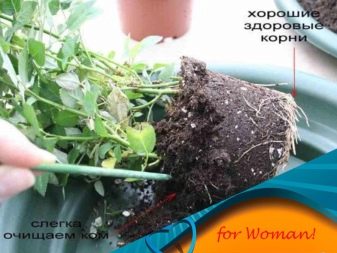
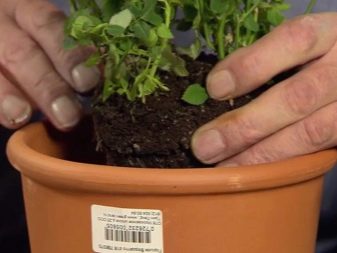
As for the pot, each time its height and diameter should increase by 2-4 centimeters. The optimal soil mixture for a miniature rose will be a specialized composition for indoor flowering crops. However, you can also prepare the nutrient soil yourself. To do this, it is necessary to mix sand or perlite with turf and greenhouse soil. Drainage is a must for all varieties of roses. You can also use coniferous and leafy soil, mixed with sand in equal proportions.

Diseases and pests
Cultures that are kept in the right conditions at home will not suffer from pest attacks, however, an ailment such as powdery mildew can overwhelm even the most blooming and well-groomed roses. It is quite simple to determine the fungus by the presence of a whitish bloom on the shoots and green mass. If a disease is detected, the flower should be treated with "Fundazol" or another fungicide.
Indoor miniature roses can also be affected by various types of spotting. Signs of such ailments are dark formations on the green mass. The causes of the appearance of the fungus are the wrong conditions of detention, which relate to the excessive moisture of the soil. In addition, the fungus can infect the foliage that is regularly exposed to moisture during watering. For the treatment of the disease, it is recommended to carry out the treatment of plants with "Fundazol" and a soap solution.


As for possible pests that are capable of attacking a flower, indoor roses can suffer from mealy mites, aphids and scale insects. To eliminate the appearance of pests, the rose should be washed weekly. If insects and traces of their activity are found on the bushes, the gardener must immediately process the rose with specialized disinfectants.
For information on how to care for indoor roses, see the video below.

































































































The comment was sent successfully.